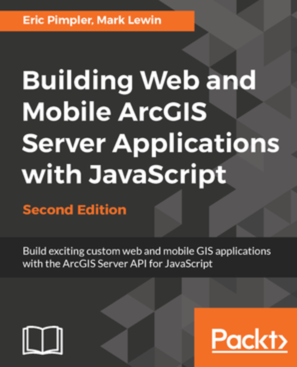We’re happy to announce that our latest book, Building Web and Mobile ArcGIS Server Applications with JavaScript, has been published by Packt Publishing. The book was co-authored by Eric Pimpler and Mark Lewin and is available for sale in both digital and hard copy formats.
Table of Contents
- Introduction to HTML/CSS/JavaScript
- Creating Maps and Adding Layers
- Adding Graphics to the Map
- The Feature Layer
- Using Widgets and Toolbars
- Performing Spatial and Attribute Queries
- Identifying and Finding Features
- Turning Addresses into Points and Points to Addresses
- Directions and Routing
- Geoprocessing Tasks
- Geometry Operations
- Integration with ArcGIS Online
- Creating Mobile Applications
- Looking Ahead to Version 4.x of the API
Book Description:
The ArcGIS API for JavaScript enables you to quickly build web and mobile mapping applications that include sophisticated GIS capabilities, yet are easy and intuitive for the user.
Aimed at both new and experienced web developers, this practical guide gives you everything you need to get started with the API. After a brief introduction to HTML/CSS/JavaScript, you’ll embed maps in a web page, add the tiled, dynamic, and streaming data layers that your users will interact with, and mark up the map with graphics. You will learn how to quickly incorporate a broad range of useful user interface elements and GIS functionality to your application with minimal effort using prebuilt widgets. As the book progresses, you will discover and use the task framework to query layers with spatial and attribute criteria, search for and identify features on the map, geocode addresses, perform network analysis and routing, and add custom geoprocessing operations. Along the way, we cover exciting new features such as the client-side geometry engine, learn how to integrate content from ArcGIS.com, and use your new skills to build mobile web mapping applications.
We conclude with a look at version 4 of the ArcGIS API for JavaScript (which is being developed in parallel with version 3.x) and what it means for you as a developer.
Related Class Information:

